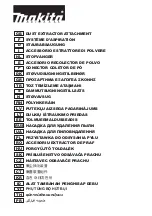
12 Part A: Introduction
© Tait Electronics Limited December 2007
Remote Connections
The TB8100 base station is designed for remote monitoring, diagnostics,
configuration, firmware upgrade, and control. The Service Kit can carry out all
these functions remotely. Provided a remote link is in place, you can connect
and log on to the base station just as if you were directly connected.
For each remotely linked base station, you need to create a ‘connection,’ which
is a named configuration that tells the Service Kit how to communicate with
the base station.
It is possible to limit remotely connected Service Kit users to read-only access
to diagnostics and configuration or even to deny access completely. Local and
remote connections have separate access profiles.
Remote connections can be modem dial-up (using RS-232) or Network (using
TCP/IP over Ethernet).
Dial-up
connections
Dial-up connections require a telephone line with modems at each end. If there
are a number of base stations at a single site, a third party asynchronous port
switch makes it possible to connect to any base station over the one telephone
line.
With an Alarm Reporting license, the base station can be remotely connected
to an Alarm Center. On Task Manager instruction, the base station uses its
modem to dial up an Alarm Center and pass on its alarm log or send a status
message for emailing. The modems must support the Hayes ‘AT’ protocol.
Network
connections
Network connections require hubs or switches, routers, and a data link with
sufficient bandwidth. The base station must be fitted with a system interface
board containing an Ethernet interface. The base station can be configured to
send alarm messages to a central third party syslog collector. A heartbeat message
can also be enabled, so that the syslog collector can report any failure of the base
station.
Summary of Contents for TB8100
Page 1: ...TB8100 base station Service Kit User s Manual MBA 00010 08 Issue 8 December 2007...
Page 8: ...vi Contents Tait Electronics Limited December 2007...
Page 12: ...2 Introduction Tait Electronics Limited December 2007...
Page 26: ...16 Part A Introduction Tait Electronics Limited December 2007...
Page 28: ...18 Getting Started Tait Electronics Limited December 2007...
Page 38: ...28 Part B Getting Started Tait Electronics Limited December 2007...
Page 40: ...30 Basic Tasks Tait Electronics Limited December 2007...
Page 74: ...64 Part C Basic Tasks Tait Electronics Limited December 2007...
Page 76: ...66 Monitoring Tait Electronics Limited December 2007...
Page 88: ...78 Part D Monitoring Tait Electronics Limited December 2007...
Page 90: ...80 Configuring the Base Station Tait Electronics Limited December 2007...
Page 106: ...96 Part E Configuring the Base Station Tait Electronics Limited December 2007...
Page 108: ...98 Configuring Channels Tait Electronics Limited December 2007...
Page 154: ...144 Part F Configuring Channels Tait Electronics Limited December 2007...
Page 156: ...146 Alarms Tait Electronics Limited December 2007...
Page 176: ...166 Part G Alarms Tait Electronics Limited December 2007...
Page 178: ...168 Diagnosing Tait Electronics Limited December 2007...
Page 198: ...188 Part H Diagnosing Tait Electronics Limited December 2007...
Page 200: ...190 Task Manager Tait Electronics Limited December 2007...
Page 254: ...244 Tait General Software Licence Agreement Tait Electronics Limited December 2007...
















































